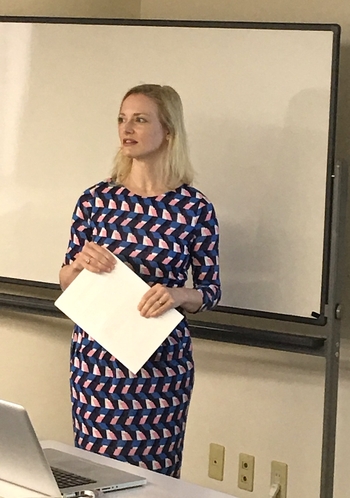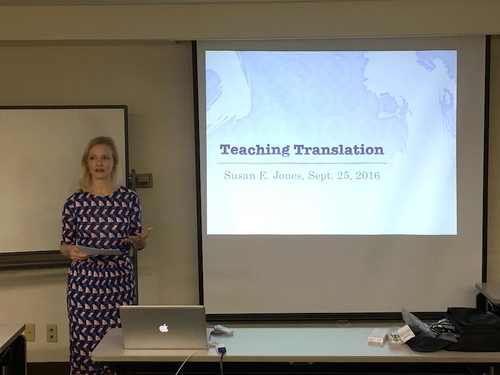November 8, 2016
Teaching Translation
SWET Presentation by Susan E. Jones
Sept. 25, 2016
Report by Don Todt
If you’re a female college student in Japan who’s interested in becoming a translator, Susan E. Jones wants you prepared.
In fact, she’s so intent on accomplishing this goal that she’s spent the last ten years developing a course in teaching translation at Kobe College (神戸女学院大学).
 Japan’s low birthrate has caused a commensurate decline in student enrollment nationwide, and colleges and universities are having to upgrade their programs and teach marketable skills in order to remain competitive. Jones says the push to provide robust translation and interpretation programs is part of that trend. The need for competent translators and interpreters for the 2020 Tokyo Olympics is also a factor. At the women-only Kobe College, the translation and interpretation specialization within the English major will soon be extended from two years to three years.
Japan’s low birthrate has caused a commensurate decline in student enrollment nationwide, and colleges and universities are having to upgrade their programs and teach marketable skills in order to remain competitive. Jones says the push to provide robust translation and interpretation programs is part of that trend. The need for competent translators and interpreters for the 2020 Tokyo Olympics is also a factor. At the women-only Kobe College, the translation and interpretation specialization within the English major will soon be extended from two years to three years.
Jones has been translating professionally since 1998, handling mainly media-related content. At Kobe College, she was given the freedom to design her own one-year J to E translation course (Translation Theory & Technique 2) for juniors who have already had a year of E to J translation experience. Her course is designed to give her non-native-English-speaking students a structured introduction to the nuts and bolts of J to E translation. Although the students are novice translators, their English level is high, since students must have a TOEIC score of at least 600 to enter the Kobe College program. The program also offers more specialized courses such as Business Interpreting, Subtitle Translation, and Conference Interpreting.
In the first semester of her course, the students do translation assignments on a wide variety of topics. “I try to dot the course with topics that I think are timely and interesting and that show students the wide variety of translation that’s out there. You can be a medical interpreter or translator. You can be a media translator. You can be a subtitle translator.” (Among the sources she uses for articles in her classes are SWET and JAT publications.) The class also discusses translation topics such as translating punctuation, dealing with katakana words, translating proper nouns, vocabulary management, and ethical issues.
One of the innovations she introduced was a Translation Notebook in which students translate one sentence every day, five days a week. The aim is to get them in the habit of translating. Jones says she got the idea from the advice of music teachers to practice daily, even just for ten minutes. “If you practice translation ten minutes a day, you’re going to get in the habit of translation, for one thing. You’re going to get faster. You’re going to get better. You’re going to get used to it. And you’re going to start thinking more like a translator.” She does not grade these translations; if the students do them, they get full credit. Graduates of her course have told her years later that they still keep a Translation Notebook to stay in practice. The Notebook is also helpful for her as a teacher, since it tells her what the students are interested in and creates a bond between teacher and student.
 In the second semester, the students tackle various types of translations: media content scripts, subtitle and manga translations (“things that I have done myself in my own work”), recipes, resumes, business emails, picture books, and so on. They also do a full-on translation project, translating a text of 1500 - 2000 characters with the goal of achieving a polished translation by semester’s end. “I found out that I had to give them due dates throughout the semester,” Jones says. “Otherwise, they would wait until January to get started.” Over the course of the project, the students do background research on the topic and author, keep a vocabulary list, do a direct translation, rewrite that translation, and then rewrite again based on the instructor’s feedback. “This gives them the chance to really get deeply into a translation, the way we do as translators,” she says. Originally Jones let the students choose their own topics, but that proved unworkable, so now she offers them a limited selection of source texts.
In the second semester, the students tackle various types of translations: media content scripts, subtitle and manga translations (“things that I have done myself in my own work”), recipes, resumes, business emails, picture books, and so on. They also do a full-on translation project, translating a text of 1500 - 2000 characters with the goal of achieving a polished translation by semester’s end. “I found out that I had to give them due dates throughout the semester,” Jones says. “Otherwise, they would wait until January to get started.” Over the course of the project, the students do background research on the topic and author, keep a vocabulary list, do a direct translation, rewrite that translation, and then rewrite again based on the instructor’s feedback. “This gives them the chance to really get deeply into a translation, the way we do as translators,” she says. Originally Jones let the students choose their own topics, but that proved unworkable, so now she offers them a limited selection of source texts.
Surprisingly, she has not had much trouble with receiving Google-translated work — possibly because at the very beginning she makes a point of showing the students how easy it is to spot a machine-translated text. (She does allow the limited use of online translation tools, but only as a supplementary learning resource.)
After completing the direct translation, the students hold a class discussion to share ideas about how to translate difficult passages and so on. At the end, the students give a short presentation about their translation project and the problems they encountered, and how they resolved those problems.
Jones says the major problem she sees in the translations done by the students is lack of attention to detail — correct spelling, consistent formatting, and so on. Repetitive constructions with one relative pronoun after another, resulting in endless run-on sentences, are also a major problem. Part of her current research is aimed at finding a way to eliminate that particular issue.
As one example of the detailed preparation she tries to give her students, Jones cited kagi-kakko (「」), which differ from English quotation marks in important ways — primarily that quotes enclosed by them are not direct quotes but paraphrases by the writer or reporter. Jones spends an entire 90-minute class on just the use of quotation marks as opposed to kagi-kakko. She says that after a few frustrating years of teaching students about English quotation marks with limited success, she took the opposite approach of starting by talking about kagi-kakko. “Because they weren’t getting it… and I realized no, we have to say ‘What is a kagi-kakko and how do we translate it?’ And then they got it…. Now we talk about quoted text or speech, titles
of large published works, short published works, so-called, ironic use, emphasis — when you can use kagi-kakko, when you can’t, when it equals the quotation mark and when it doesn’t.” By way of illustration, Jones showed a slide from her sample lecture on kagi-kakko that consisted of nothing but a big red STOP sign. She urges her students to stop when they see kagi-kakko and ask themselves what the purpose of the kagi-kakko is, in order to know how to handle them. “You see a kagi-kakko, you stop immediately and say, why is it there?… And then you know what choice to make… because you’re going to look at your handy chart that I made for you, and it’s going to tell you what to do.”
In terms of challenges for the teacher, Jones says it still takes her a long time to evaluate student translations. After initially struggling to find a way to quantify their work and assign a numerical grade, she says that now she takes points off for sloppiness and adds points for translations that have obviously been done with extra care.
Although she doesn’t use them in her classes, Jones mentions the following two books on teaching translation: The Routledge Course in Japanese Translation by Yoko Hasegawa, which has an emphasis on linguistics, and An Introduction to Translation and Spoken Language Interpreting (踏み出せ!通訳・翻訳の世界) published by Osaka Kyoiku Tosho. Jones also plans to put together her own manual for teaching translation, based on the program she has developed.
In addition to creating a curriculum and selecting teaching materials, Jones says the third challenge for those setting up a translation teaching program is finding qualified instructors. She says that, in her judgment, it is more profitable to work as a full-time translator as opposed to doing both teaching and translating part-time, so finding translators who are willing to teach may continue to be a challenge. But Jones says it is a challenge worth pursuing. “The knowledge gained through professional experience in the field is an invaluable resource for students.”
While the difference between classroom learning and real-world translation can be stark, the shock can be minimized by giving students the opportunity to take on professional translations before graduation. This is already in place for graduate students at Kobe College; the graduate translation and interpretation program already requires a certain number of OJT hours for graduation. Jones says that if a similar program for undergraduates were implemented, it would enable them to get practical experience in translation as a career and business, while at the same time providing a service to the community.
As for Jones, the first ten years is just the beginning. After years of teaching part-time, starting in 2017 she’ll be a full-time instructor at Kobe College, focusing on the further development of the translation and interpretation program. And she’ll also be working on her own translation manual. So her goal remains the same: finding more ways to better prepare students to become full-fledged professional translators.
